| Release List | Reviews | Price Search | Shop | Newsletter | Forum | DVD Giveaways | Blu-Ray/ HD DVD | Advertise |
| Reviews & Columns |
|
Reviews DVD TV on DVD Blu-ray International DVDs Theatrical Reviews by Studio Video Games Features Collector Series DVDs Easter Egg Database Interviews DVD Talk TV DVD Talk Radio Feature Articles Columns Anime Talk DVD Savant HD Talk Horror DVDs Silent DVD
|
DVD Talk Forum |
|
|
| Resources |
|
DVD Price Search Customer Service #'s RCE Info Links |
|
Columns
|
 |
Ray Harryhausen Collection: |
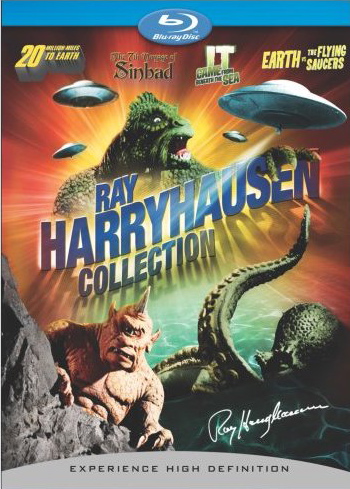
|
Ray Harryhausen Collection It Came from Beneath the Sea, Earth vs. the Flying Saucers, 20 Million Miles to Earth, The 7th Voyage of Sinbad Blu-ray Sony Home Entertainment 1:85 and 1:66 widescreen / Street Date October 7, 2008 / 107.95 Starring Kenneth Tobey, Faith Domergue, Hugh Marlowe, Joan Taylor, William Hopper, Kerwin Mathews, Kathryn Grant, Torin Thatcher, Richard Eyer Produced by Charles H. Schneer Directed by Robert Gordon, Fred F. Sears, Nathan Juran Special Effects Ray Harryhausen |
"Some of us have always been attracted to the art of stop-motion. You can feel the artist at work making this creature." -- Dennis Muren
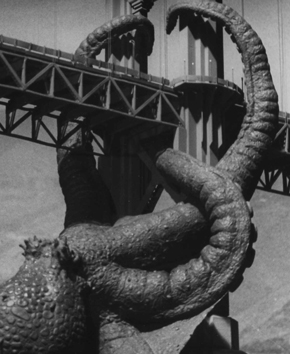
Although stop-motion animator Ray Harryhausen released his last feature film over 28 years ago, for film aficionados he's still the most popular "creator of special visual effects". Thanks to theatrical revivals, new books and a star on the Hollywood Walk of Fame, Harryhausen is one of the most sought-after celebrities at conventions and book signings.
Many of Ray's fans were born too late to have seen any of his pictures when they were new. Even this particular enthusiast was too young for the original openings of the fantastic pictures in Sony's new Ray Harryhausen Collection, which contains his first four Columbia titles in remastered Blu-ray high definition. The first three are each viewable in their original B&W and in alternate colorized versions, a dubious marketing choice that hasn't harmed their reputations.

Ray Harryhausen's career is a tale of a talent too unique to be suppressed. He was lucky enough to find a producer appreciative of his special talents, something that always eluded his mentor Willis O'Brien. Charles H. Schneer had an "in" at Columbia and managed to launch It Came from Beneath the Sea under the umbrella of the prolific Sam Katzman. Harryhausen's contribution made all the difference, turning some weak dialogue scenes and stock footage into a spectacle that completely overshadowed the cheapie sharing Katzman's double bill, Creature with the Atom Brain. Submarine commander Kenneth Tobey exchanges bedroom eyes with Faith Domergue, and a "scientific" briefing uses a toy balloon to explain the giant octopoid's underwater propulsion system, but no school kid ever forgot the sight of Ray's colossal monster oozing its way onto the Golden Gate Bridge.
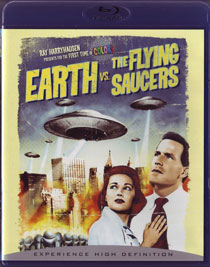
Schneer and Harryhausen's reward for making something out of almost nothing was to do it all over again, just as cheaply. Earth vs. the Flying Saucers is an orgy of ray-gun blasting alien spaceships interacting with every scrap of stock footage known to modern man. With no monster to animate Harryhausen concentrates on spectacular destruction, using double exposures to portray ray blasts, gunfire, the shimmer of force fields and the sight of a man's brain being lobotomized by alien abductors. The sheer number of illusions carries the day. Harryhausen paid his dues as a solo effects genius and established a reputation for bankability. All of his very cheap science fiction films were highly profitable ... a record even George Pal could not touch.
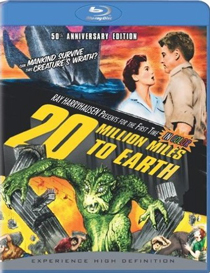
With 20 Million Miles to Earth Schneer graduated to sole producer status and stock footage searches were replaced by location shooting in Rome. Harryhausen perfected his miniature rear projection techniques, creating an interesting Venusian humanoid-lizard monster that grows into a Kong-sized problem. Columbia probably didn't care how Harryhausen was pulling off these illusions, but the money men gave a green light to Schneer's proposal that the next show be filmed in color.
The 7th Voyage of Sinbad is a pivotal film for the newer generation of special effects artists. Harryhausen fields not one but five fantastic creatures, led by a grimacing Cyclops that induces scares as well as
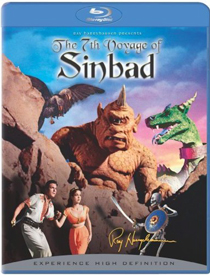 thrills. The illusion of Sinbad dueling with a demonic skeleton was so unexpected that even skeptical 50s kids watched in awe. Kenneth Kolb's script is short on poetry, but it at least takes the storybook tale seriously. Harryhausen finally gets a cast worthy of his ambitions. As a sober and earnest Sinbad, Kerwin Mathews has a talent for mime that adds greatly to his heroic monster encounters. The underrated Torin Thatcher is the marvelously evil wizard Sokurah.
thrills. The illusion of Sinbad dueling with a demonic skeleton was so unexpected that even skeptical 50s kids watched in awe. Kenneth Kolb's script is short on poetry, but it at least takes the storybook tale seriously. Harryhausen finally gets a cast worthy of his ambitions. As a sober and earnest Sinbad, Kerwin Mathews has a talent for mime that adds greatly to his heroic monster encounters. The underrated Torin Thatcher is the marvelously evil wizard Sokurah.
The name "Dynamation" was coined to ballyhoo Harryhausen's "new electronic process." 7th Voyage's Arabian Nights appeal is aided by impressive locations and superb music. Spanish beaches and Majorcan grottoes add menace to the island of Colossa, while Bernard Herrmann's dynamic score elevates the budget-conscious fairytale and adds distinction to the violent action scenes. Sinbad's crew fares no better than Carl Denham's on Skull Island -- sailors are crushed, roasted and knocked off cliffs by a giant two-headed vulture. With one jaw-dropping "Did You See That?" moment following another, nobody in 1958 noticed details like Sinbad's ship changing shape from stock shot to stock shot. Of course, today we can't help but react to Sokurah's prophecy for the peaceful Baghdad: "There are great buildings falling ... women and children slain. I see ... war!"
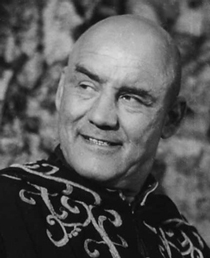
The popularity of Ray Harryhausen is stamped on every disc in Sony's Ray Harryhausen Collection. A single 20 Million Miles to Earth Blu-ray has already been released, which will frustrate collectors trying to avoid buying the same disc twice. The first three titles all look sharp and detailed in the higher resolution of Blu-ray, which also allows a more exacting examination of Harryhausen's craft. Stock shots and rear-projected effects scenes are of course softer and have more grain, which is exactly as the films looked when new.
The extras on the first three discs are plentiful but uneven in quality. Harryhausen business partner Arnold Kunert appears on all the commentaries with Harryhausen and effects experts like Ken Ralston, Dennis Muren, Phil Tippett and Randall William Cook. Making-of featurettes allow Harryhausen to re-tell stories that even casual fans have heard many times over. The Tim Burton and John Landis interviews are repeated from earlier discs, along with input from music experts on the film scores and an overlong interview with a Writer's Guild spokesman about the blacklisted Bernard Gordon. Actress Joan Taylor makes a pleasant interview appearance and the galleries of stills and artwork are exhaustive. The colorization infomercials posing as featurettes have also been ported over from the DVD releases.
The big attraction is seeing what Sony has done with everyone's favorite, The 7th Voyage of Sinbad for HD. The color is very impressive, dark and rich where earlier transfers were washed out. Some effects scenes have more grain than others, with a few isolated moments -- like a grungy sky during the fight with the Roc -- veering to the disappointing side. Also, digital processing has partially erased the tip of the Cyclops' horn as well as a few blurred spears during fast motion frames; animation analysts won't like that. Less distracting but certainly odd is the fact that the two-headed Roc chick is now a fluffy white, when Ray Harryhausen confirms that it was originally yellow. But overall the image will be very pleasing to viewers aware of what it takes to restore a 50 year-old Eastmancolor film.
One happy improvement is Sony's decision to transfer Sinbad at 1.66:1 instead of the 1.85 ratio used for the other titles. The compositions finally appear correct, no longer cutting off the "monster feet" at the bottom of the frame. Even better, Bernard Herrmann's music is clearer than ever before, in true stereo on a new lossless 5.1 track. The original mono is included as well.
Here's what Grover Crisp, VP in charge of film restoration projects at Sony, had to say about his department's work on The 7th Voyage of Sinbad:

"Hi Glenn -- Nice to hear from you and glad that you recognize improvements. The original negative is faded and was not easy to deal with. We worked with a lab to restore the color as best as possible photo-chemically, and then completed that part digitally, of course. None of it is from separations. I wanted to get the color back into the image because I think all earlier home video releases did not do justice to the film in that regard. I took the lead from working with Ray over the years on making prints of the film as to how it should look. We also tried to take out dirt and scratches and things like that.
Also, you will notice that it is formatted in the 1.66:1 ratio. As you no doubt know, he basically shot all his effects work 1.33, but with the idea that they could be framed 1.33, 1.66 or 1.85 and still work. We usually show it 1.85 in theatres, but I always felt it looked best 1.66. So, when I asked Ray what he thought of the Sinbad Blue-ray, he definitely agreed that it should be 1.66. By the way, to format the film for 1.33 you have to carefully frame it, and even blow-up some shots, to avoid some of the obvious effects mattes and so forth.
This being Blue-ray with the wish from everyone for a stereo track, we also went on a hunt and came up with original stereo score elements (not fake stereo) for most of the film. It really adds to the experience, but I didn't want to go overboard with it, either. This has always been my favorite Bernard Herrmann score so I was very happy to oversee the mix, and happy with the result. I ordinarily do not like to do this, especially when a film was originally released mono as this one most emphatically was. But I figure if it is going to be done, I might as well do it.
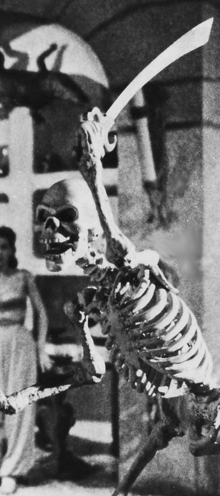
Lastly, just as we were finishing this new transfer, the grain issue for Blue-ray started raging on the web, mostly surrounding the release of couple of non-Sony titles. Sinbad is a very grainy film in some people's minds (not mine). Any film produced the way this one was, with all those traditional opticals and effects, is bound to show more grain on HD. But with everyone nervous about (and still arguing about) grainy, soft looking films, I looked at several tests to reduce grain in a number of areas, the main title sequence being one.
In the end, and it was my sole decision, we did absolutely nothing to the grain. For two reasons -- one, the film is what it is and, for me, this is what HD and Blue-ray are all about. People forget why it's called Home "Theater", and I very much support the notion of replicating the theatrical experience in the home, even if it means some will think we did not "do enough" on the transfer. Secondly, I think it a good test for those who say they don't mind grain, but frankly always comment on it. Okay, enough soapbox stuff and I am sure much more than you wanted to hear from your question. -- Grover"
The 7th Voyage extras are okay but not sensational, the best entry being Harryhausen's Remembering ... interview piece. He's sharp and focused and brings up a number of interesting effects issues and details I hadn't thought about before. The crowded commentary includes Ray, Arnold Kunert, Phil Tippett, Randall William Cook and author Steven Smith, whose input is redundantly covered in the separate The Music of... featurette. Oscar winners Tippett and Cook are left with less space to quiz Harryhausen on the nuts and bolts of his wizardry. They do manage to express their fundamental devotion to their filmic mentor.
The Harryhausen Legacy is an overlong collection of enthusiastic testimonials to Ray's genius by latter day effects experts. A Look Behind the Voyage is a vintage interview piece with Ray and his producer Charles H. Schneer. The old This is Dynamation trailer and some handsome galleries follow, along with a music video cut to a vintage novelty song released as a 7th Voyage tie-in, Sinbad May Have Been Bad, But He's Been Good To Me. If the tune were a bit better, it could serve as Harryhausen's theme song.
The 7th Voyage of Sinbad is strongly recommended. If you've never seen it, the Blu-ray disc will be a real knockout.
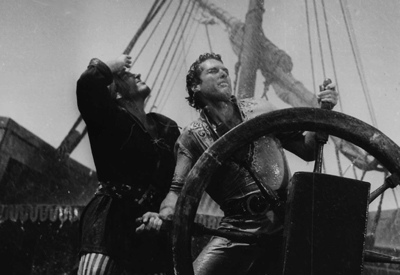
Earlier DVD Savant reviews of the same films on DVD:
20 Million Miles to Earth
The 7th Voyage of Sinbad
On a scale of Excellent, Good, Fair, and Poor,
the Ray Harryhausen Collection Blu-ray rates:
Movie: It Came from Beneath the Sea: Good, Earth vs. the Flying Saucers: Very Good, 20 Million Miles to Earth: Very Good ++, The 7th Voyage of Sinbad: Excellent
Video: Excellent with occasional issues
Sound: Excellent +
Supplements (beware repeats): It Came from Beneath the Sea: Commentary with Harryhausen, Randall William Cook, John Bruno, and Arnold Kunert; featurettes Remembering It Came from beneath the Sea, Tim Burton Sits down with Ray Harryhausen, David Schecter on Film Music's Unsung Hero, A Present-Day Look at Stop-Motion, Comic book promo, galleries. Earth vs. the Flying Saucers: Commentary with Ray Harryhausen, Jeffrey Okun, Ken Ralston, and Arnold Kunert; Featurettes Remembering Earth vs. the Flying Saucers, The Hollywood Blacklist and Bernard Gordon and Tim Burton Sits Down with Ray Harryhausen; Interview with Joan Taylor, A Present-Day Look at Stop-Motion, David Schecter on Film Music's Unsung Hero, Comic book promo, original screen credits, galleries, Colorization promo. 20 Million Miles to Earth: Commentary with Harryhausen, Dennis Muren, Phil Tippett and Arnold Kunert; featurettes Remembering 20 Million Miles to Earth, Tim Burton Sits Down with Ray Harryhausen, The Joan Taylor Interview; Arnold Kunert explains posters and other campaign art; Mischa Bakaleinikoff: Film Music's Unsung Hero, Colorization promo, galleries. The 7th Voyage of Sinbad: Commentary with Harryhausen, Steven Smith, Randall William Cook, Phil Tippett; featurettes Remembering The 7th Voyage of Sinbad, The Harryhausen legacy, The Music of Bernard Herrmann, A Look Behind the Voyage, This Is Dynamation; John Landis interview, Galleries, music video.
Packaging: Four discs in four keep cases in card sleeve
Reviewed: October 3, 2008
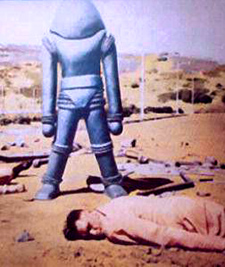
Mighty Joe Young
The Beast from 20,000 Fathoms
Earth vs. the Flying Saucers
20 Million Miles to Earth
The 7th Voyage of Sinbad
The Three Worlds of Gulliver
Mysterious Island
First Men In the Moon
One Million Years B.C.
The Valley of Gwangi
The Golden Voyage of Sinbad
Clash of the Titans
Ray Harryhausen: The Early Years Collection
The Hollywood Children of Ray Harryhausen (article)
Reviews on the Savant main site have additional credits information and are more likely to be updated and annotated with reader input and graphics.
Review Staff | About DVD Talk | Newsletter Subscribe | Join DVD Talk Forum
Copyright © MH Sub I, LLC dba Internet Brands. | Privacy Policy
Subscribe to DVDTalk's Newsletters
|
| Release List | Reviews | Price Search | Shop | SUBSCRIBE | Forum | DVD Giveaways | Blu-Ray/ HD DVD | Advertise |





